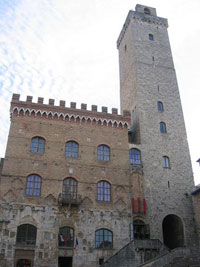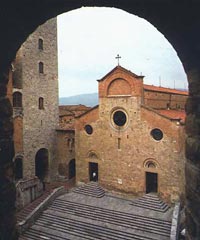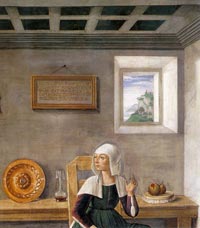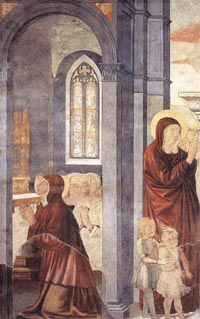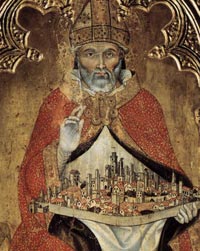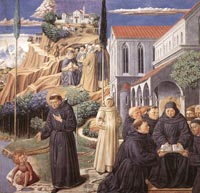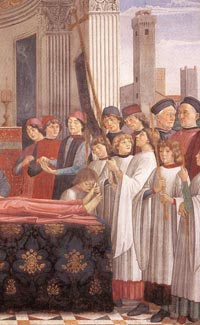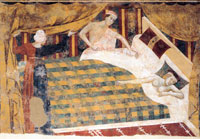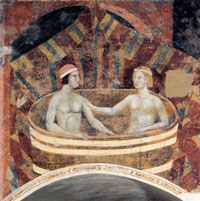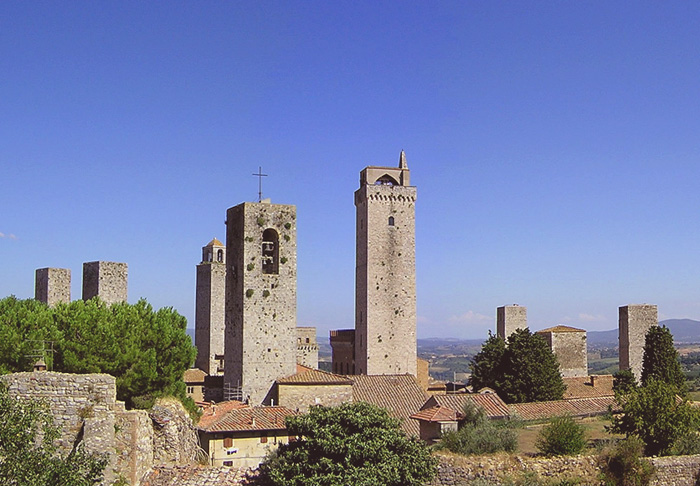 |
|
San Gimignano
|
|
|
|
There is no history that is not designed, no design that is not historical, and no single form of authenticity[0]. |
|
|
San Gimignano is one of the best-preserved Italian medieval towns, with city walls, gates, and 14 of its famous old towers remaining intact. These towers, characteristic of San Gimignano, once numbered 72, were built by leading families vying with each other for prestige. The historic town centre was designated a UNESCO World Heritage site in 1990. San Gimignano was founded as a small village in the 3rd century BC by the Etruscans. In the Middle Ages and Renaissance, it was a stopping point for Catholic pilgrims on their way to Rome and the Vatican, as it sits on the medieval Via Francigena. Taking advantage of the wealth that arrived in the city from the Francigena and because of its position at the borders between Siena and Florence, together with the political weakening of Volterra, the zone of the Val d' Elsa was an ideal theater for the development of local autonomy. In San Gimignano the economy of the merchants grew into a powerful force that led to the emergence of a great city. San Gimignano received the Italian Orange Flag award for sustainable tourism. San Gimignano's most notable monuments are the Palazzo del Popolo (1288–1323), containing the civic museum and picture gallery, the Collegiata, formerly a cathedral, decorated with numerous frescoes, and the church of Sant’ Agostino (1280–98), housing a wide representation of artworks from some of the main Italian renaissance artists, among them frescoes by Benozzo Gozzoli depicting scenes from the life of St. Augustine. |
||
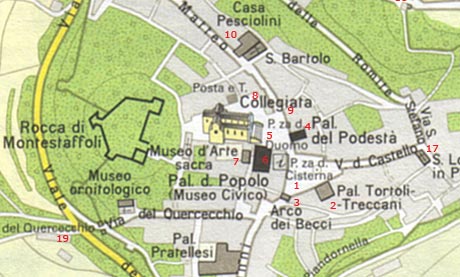 |
1 |
Piazza della Cisterna |
2 |
Palazzo Tortoli | |
3 |
Arco dei Becci | |
4 |
Palazzo del Podestà | |
5 |
Piazza del Duomo | |
6 |
Palazzo del Popolo | |
7 |
Museo d'Arte Sacra, Museo Etrusco | |
8 |
Torri Salvucci | |
9 |
Palazzo Cancelleria | |
10 |
Palazzo Pesciolini | |
11 |
Palazzo Tinacci | |
12 |
San Pietro | |
13 |
Piazza Sant'Agostino | |
14 |
San Iacopo | |
15 |
Porta San Iacopo | |
16 |
Porta d. Fonti | |
17 |
San Lorenzo in Ponte | |
18 |
Porta San Giovanni | |
19 |
Porta Quercecchio | |
20 |
Porta San Matteo | |
|
||
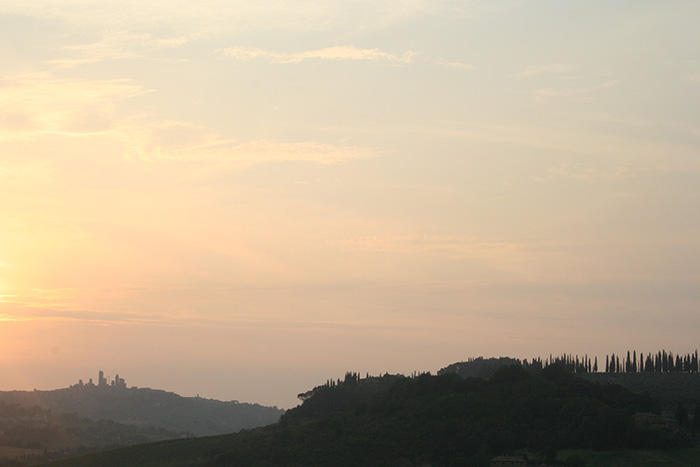 |
||
Sunset with San Gimignano towers. How prescient the nobles of San Gimignano were in building
|
||
Palazzo del Popolo |
||
The Palazzo Comunale (Italian: Municipal palace) of San Gimignano, also known as the Palazzo del Popolo, is in the Piazza del Duomo, close to the Collegiata church. The building contains a museum and gallery with works of the Florentine and Sienese schools of art - including works by Coppo di Marcovaldo, Lippo Memmi, Benozzo Gozzoli, Filippino Lippi, Il Sodoma and Pinturicchio. The palazzo dates from the late 13th century, and was built on the ruins of an existing building between 1289 and 1298. Further expanded in the 14th century, the facade is characterised by arched windows, with the lower half of the frontage built with stone, and the upper part in brick. The frescoes by Memmo di Filippuccio which the township commissioned in 1303 to decorate the chambers of the podestà in the Palazzo del Popolo are among the most frequently reproduced documents used to illustrates daily life, down to its most domestic details, of the early 14th century. [3] The upper stories of the palazzo house the Sala del Consiglio, and the civic museum and gallery. The "Sala del Consiglio" is a large reception hall which was used as the council chamber. It is commonly known as the Sala di Dante and is named for the noted poet Dante Alighieri who visited San Gimignano in 1300 as an ambassador of the Florentine Republic. The room is decorated with a Maestà by Lippo Memmi. Commissioned in 1317 by Nello de Mino Tolomei (then podestà of San Gimignano), the fresco is believed to have been inspired by Simone Martini's Maestà from the Palazzo Pubblico in Siena. The paired figures to the left and right were added by Bartolo di Fredi when the fresco was enlarged in 1367. The fresco was repaired along the lower edge in the 1460s by Benozzo Gozzoli, who may have repainted the heads of the two figures to the far right. In front of the Palace and the Tower, a ballatoio (stairs leading to and from a narrow terrace) called l’Arengo can be admired. Art in Tuscany | Palazzo Publicco in San GImignano
|
|
|
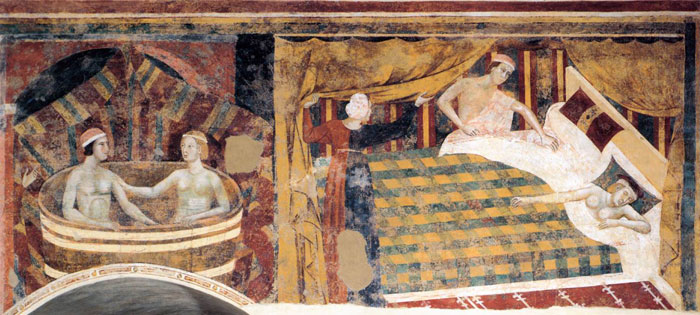 |
||
Memmo di Filippuccio, Erotic scenes, 1300-10, fresco, Palazzo del Podestà, San Gimignano |
||
The Chiesa Collegiata is the main church of San Gimignano, situated in the Piazza del Duomo at the town's heart. It was once the Duomo (cathedral), but since San Gimignano no longer has a bishop it has reverted to the status of a collegiate church. The façade dates from 1239 and is remarkably plain. The Pisan Romanesque interior is famous for its lavish frescoes, which almost entirely cover the walls. The arcades are of black and white striped marble. In the centre is a large fresco of "St Sebastian" by Benozzo Gozzoli (1465), commissioned after the plague had hit the town in 1464. A fresco cycle by Taddeo di Bartolo depicts the "Last Judgement" in gruesome detail. The two main chapels are the Cappella di San Gimignano, with an altar by Benedetto da Maiano, and the Cappella di Santa Fina, designed by Giuliano da Maiano, with the sculpture by his brother Benedetto. Domenico Ghirlandaio painted the frescoes in the latter chapel. St Fina was born in San Gimignano in 1238, contracted an incurable disease when she was ten and spent the five years until her death lying on a board to increase her suffering before God. On her death the board was covered in flowers. The heart of San Gimignano contains four squares, Piazza della Cisterna, Piazza Duomo where the Collegiata is located, Piazza Pecori, and Piazza delle Erbe. The main streets are Via San Matteo and Via San Giovanni, which cross the city from north to south. Piazza della Cisterna represents the middle of the village, it has a triangular shape and it takes the name from the cistern placed inside the square, built in 1237 and enlarged in 1346. Palazzos and towers, alternating in a rare harmony of volumes and spaces, surround the irregularly triangular brick paving that narrows towards Via del Castello. The square skirts the following buildings: Razzi House with mullioned windows, Salvestrini House Thirteenth-century construction (today is an Hotel), Palazzo Tortoli with its four elegant 14th century two-light windows, Lupi Palace and its tower of the Devil, the truncated Pucci tower, named after the family who owned it between the 19th and 20th centuries, and, with its two towers, Palazzo Ardinghelli. On the other side of the piazza, Palazzo Lupi with the Torre del Diavolo (it is said that the owner, returning from a long journey, found that it had inexplicably become higher and put this down to demonic intervention) and the 15th century Palazzo Cortesi-Lolli. From Via del Castello an alleyway on the right leads after a short walk to the House of Santa Fina. The very young saint had suffered a long series of physical and moral tribulations which she accepted for love of Christ. She spent much of her brief life immobilised on a wooden pallet in the cellar of her humble house. The house is now a chapel that may be visited on her feast day, 12th March. The Piazza del Duomo is paved and surrounded with buildings and towers. On a high stairs, dominates the Collegiate Church of S. Maria Assunta (XII century), rich in 1300 Sienese and 1400 Florentine paintings, and the Chapel of Santa Fina. In the opposite there is the Podestà Palace surmounted by Rognosa Tower, utilized during 1300 as the State prison. In front of the Dome we can see the building of Ghibellini-Salvucci with the Twin Towers that heads Chigi Tower (1280). |
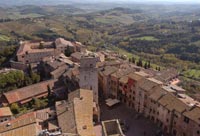 San Gimignano, view from Rocca di Montestaffoli |
|
|
||
| Before leaving Via Francigena by way of Porta San Matteo, situated on the north side of the road, if you turn right into Via Cellolese you arrive in the splendid Piazza Sant'Agostino. The cistern in the centre is framed by the splendid Chiesa di Sant' Agostino, with the annexed monastery complex and the small Romanesque church of San Pietro in Forliano. The Chiesa di Sant' Agostino is a single-aisled hall church with three apsidal chapels and an open roof truss. It was built by the Augustinian canons between 1280 and 1298, and it represents a typical example of the Gothic architecture of the mendicant orders in central Italy. Benozzo Gozzoli, in collaboration with several assistants, produced here his main work, the decorations of the apsidal chapel of the church in 1464-65. [read more]. The Church of San Lorenzo in Ponte, in Via del Castello, close to the former Monastery of St Dominic, was built in Romanesque style in 1240. The gallery was closed in 1561 to turn it into an oratory. Inside there is a cycle of frescoes with stories of St Benedict and, at the bottom, a great fresco with the Glory of Christ, the Virgin and the 12 Apostles by Cenni di Francesco di Ser Cenni, dated around 1413. The Romanesque Church of San Bartolo is n Via San Matteo, after Palazzo della Cancelleria. The brick façade, built in 1173, has an elegant series of blind arches set in two orders of different size and standing on half-columns. La Rocca di Montestaffoli From Piazza del Duomo, proceeding to the right of the Duomo itself and crossing the lovely Piazza delle Erbe, you come to the Rocca di Montestaffoli. This fortress was built by the Florentines in 1353. Only a few shattered remains are left of this Rocca, but its highest point offers one of the most beautiful views of the towers of San Gimignano. Musei Civici di San Gimignano, Palazzo Comunale, Pinacoteca, Torre Grossa. Raffaele De Grada Gallery of Modern and Contemporary Art | ||
The Romanesque church Pieve di Cèllole, which inspired Giacomo Puccini's Suor Angelica, is located in Cèllole, just a few kilometres from San Gimignano in the fortified village of Collemuccioli. There are Etruscan tombs nearby (Poggio alla Città). Places worth visiting in Collemuccioli are the Piazza dei Priori, one of Italy's most beautiful squares surrounded by impressive 14th century buildings; the Priori Palace, the municipal Picture Gallery, the Romanesque Cathedral, the Baptistry, the arch Porta all'arco, the Etruscan acropolis, the Medicean fortress named Maschio, alley Viale dei Ponti, Matteotti street, the Etruscan Museum Guarnacci with thousands of funeral urns dating back to the Hellenistic and Archaic periods, the archaeological excavations of the Roman amphitheatre and the tombs in Valle Bona.
|
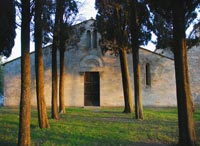 Pieve di Cèllole |
|
Weekly market in San Gimignano is on Thursdays (Piazza Duomo, Piazza della Cisterna (8.00 -13.00).
|
||
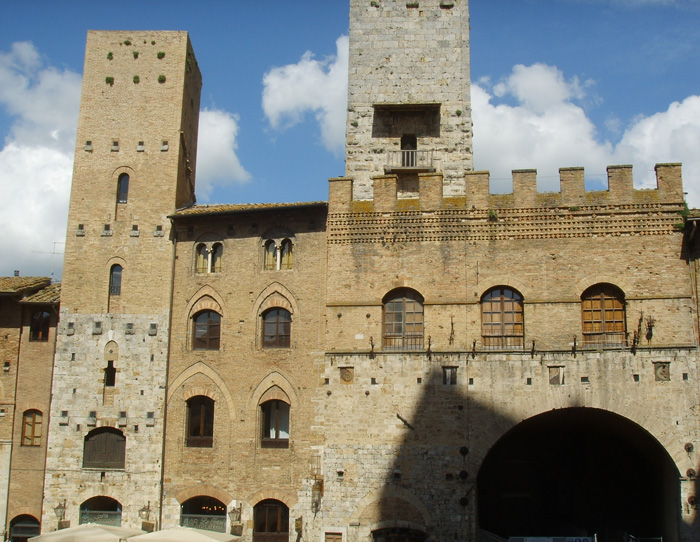 |
||
Piazza del Duomo e palazzo del Podestà (sec. XIII), San Gimignano [2]
|
||
Galleria Continua | Via del Castello, 11 - 53037 San Gimignano (SI) Arte all'Arte. Arte Architettura Paesaggio is an event conceived and organized by Associazione Arte Continua of San Gimignano.Each year six international artists from six different countries are invited to devise a specific project for the six councils involved in the initiative. The artists spend some time in the towns and then each one produces a site-specific work in a public space. |
||
Walking in Tuscany | Walking and trekking around San Gimignano |
||
The municipality and the entire province of Siena offer an infinite variety of trekking and cycling itineraries. Paths and tracks which, in the case of the San Gimignano area, wind through valleys and hills, woodland and open country. On foot from San Gimignano you can reach Castelvecchio, the village of Lariano and the Romanesque parish church of Cèllole, the sanctuary of the Madonna di Pancole. There are many routes, on foot or by bicycle. |
||
Castelvecchio Nature Reserve (734 hectares) is situated in Val d’Elsa, a few kilometers westwards from San Gimignano. The ruins of Castelvecchio, from where you can enjoy a wonderful view over the surroundings, are a reference point for the hikes in the Reserve. The Castelvecchio castle was an important fort during the medieval period. It had the advantage of a natural line of defense provided by two small rivers, the Botro di Castelvecchio and the Botro della Libaia, both tributaries of the larger river Elsa. |
||
| From Gambassi Terme to San Gimignano - 13,4 km |
||
| A short stage, however an interesting one for the beauty of the landscape along the Via Francigena. Exiting from the centre of Gambassi Termi, one goes towards the Luiano farm, passing through terrain cultivated with vineyards. Once past the farm, we encounter the bridge of the Madonna, on the Torrente dei Casciani which marks the confine between the provinces of Florence and Siena and the entrance to the municipality of San Gimignano. From here the route goes uphill past cultivated fields and beautiful cypresses until reaching Pancole, the site of a Marian sanctuary and a place for refilling water. The route involves going through the underground passage of the large religious structure. Shortly after, one can already glimpse the multi-towered profile of San Gimignano. But before reaching the town we encounter the charming Romanesque parish church of S. Maria a Cellole, completed in 1238, as recorded in an inscription to the side of the portal. From the church, passing the houses of Sferracavalli, one can take a brief detour to visit an Etruscan necropolis with well-preserved hypogeous room tombs that date between the 4th and 1st century BC. There is no rest point along the route. The Via Francigena in the Siena Region | From Gambassi Terme to San Gimignano Via Francigena | Da San Gimignano a Monteriggioni |
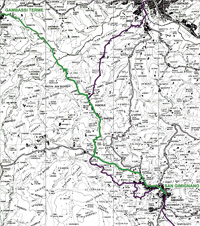
|
|
View Larger Map |
||||
Siena Communities | Abbadia San Salvatore · Asciano · Buonconvento · Casole d'Elsa · Castellina in Chianti · Castelnuovo Berardenga · Castiglione d'Orcia · Cetona · Chianciano Terme· Chiusdino · Chiusi · Colle di Val d'Elsa · Gaiole in Chianti · Montalcino · Montepulciano · Monteriggioni · Monteroni d'Arbia · Monticiano · Murlo · Piancastagnaio · Pienza · Poggibonsi · Radda in Chianti · Radicofani · Radicondoli · Rapolano Terme · San Casciano dei Bagni · San Gimignano · San Giovanni d'Asso · San Quirico d'Orcia · Sarteano · Siena · Sinalunga · Sovicille · Torrita di Siena · Trequanda |
||||
|
|
||||
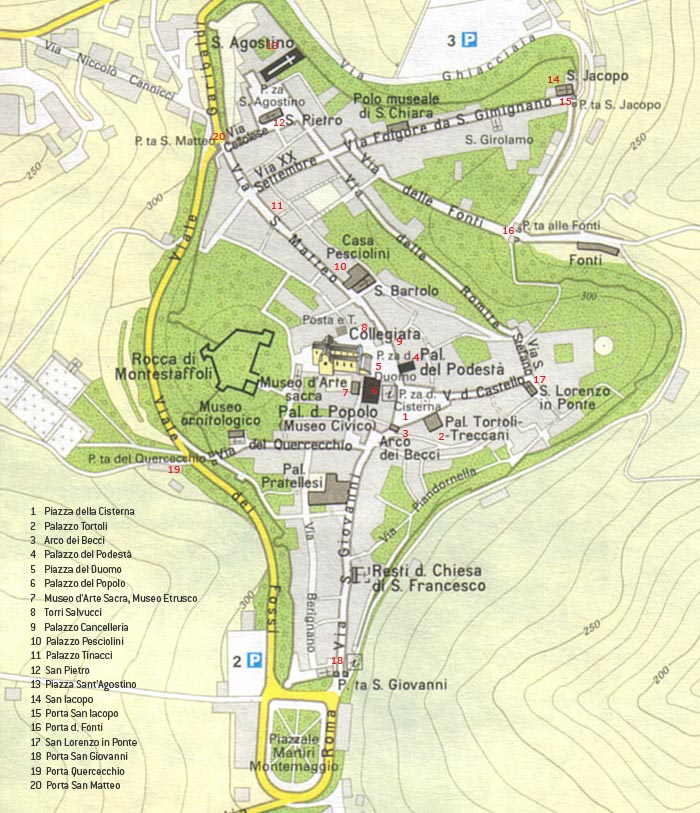 |
||||
|
[0] From the preface of D. Medina Lasansky, The Renaissance Perfected. Architecture, Spectacle, and Tourism in Fascist Italy, University Park: Pennsylvania State University Press, 2004.
|
||||
La Chiesa di Sant' Agostino, fresco cycle of St Augustine by Benozzo Gozzoli |
||||
| The single-aisled hall church with three apsidal chapels and an open roof truss, built by the Augustinian canons between 1280 and 1298, is a typical example of the Gothic architecture of the mendicant orders in central Italy.By 1463 at the latest, Benozzo had left his native city and moved to San Gimignano for four years, until 1467. Here, in collaboration with several assistants, he produced his main work, the decorations of the apsidal chapel of the church of Sant'Agostino (1464-65). The paintings were produced within the contemporary context of the reformation of the monastery of Sant'Agostino. The choir, being the place where the community of monks assembled, was decorated with a didactic program of the life and work of St Augustine. The cycle of St Augustine is one of the main works of Tuscan narrative art dating from the middle of the century. The cycle depicts 17 scenes from the life of the Father of the Church. As in the cycle of St Francis in Montefalco, the cycle of St Augustine does not depict any miracles or posthumous events, but portrays the saint as a student, teacher and scholar. The cycle is read from the bottom upwards, and as a result should be interpreted as a painted metaphor of a striving to reach God. The 17 pictures, which are arranged in three rows, use the traditional horizontal direction of reading, from the bottom left to the top right. In the lowest register he depicts the education, teachings and journeys of the saint. The middle register shows his path to Christian faith, and finally, in the lunette fields the culmination of his journey through life appears. |
||||
Colleggiata, the Stories of St Fina by Domenico Ghirlandaio |
||||
Between 1468 and 1472, architect Giuliano da Maiano built Saint Fina's mortuary chapel in the collegiate church and Domenico Ghirlandaio covered the walls with frescoes. His brother Benedetto da Maiano created the saint's burial altar about 1475. Both artists were working in direct competition with each other, for they were depicting the Obsequies of Saint Fina side by side, each using his own medium, fresco and relief carving. It was in the frescoes for this chapel Ghirlandaio was able to develop his own style. The two frescoes in the Saint Fina Chapel are the first major works of Ghirlandaio's career. There are already signs of the architecture that will feature in his later works, here imaginatively and skillfully constructed according to the laws of perspective. There are two Stories of St Fina: the Apparition to Fina of St Gregory who announces her Death and the Obsequies of the Saint. The immediate inspiration for the composition of the Obsequies of the Saint was Fra Filippo Lippi's fresco in the choir of Prato Cathedral, the Obsequies of Saint Stephen. Ghirlandaio would later create another variation on this composition in a fresco for the Sassetti Chapel in Florence. In the long row of expressive heads Ghirlandaio already reveals his unique ability to create convincing character studies, a skill that was to bring him fame and many well paid commissions. Some of those depicted do not seem to be taking part in the ceremony, while others are deeply moved. The server at the saint's feet is more interested in his processional cross than in the ceremony, and the server next to him is looking around to keep himself amused. Domenico Ghirlandaio (1449-94) was a Florentine painter. He trained with Baldovinetti and possibly with Verrocchio. His largest undertaking was the fresco cycle in the choir of Sta Maria Novella, Florence, illustrating Scenes from the Lives of the Virgin and St John the Baptist (1486-90). It is this talent for portraying the life and manners of his time (he often included portraits in his religious works) that has made Ghirlandaio popular with many visitors to Florence. But he also had considerable skill in the management of complex compositions and a certain grandeur of conception that sometimes hints at the High Renaissance. Ghirlandaio worked on frescos in Pisa, San Gimignano, and Rome (in the Sistine Chapel) as well as in Florence, and his studio produced numerous altarpieces. Ghirlandaio's son and pupil Ridolfo (1483-1561) was a friend of Raphael and a portrait painter of some distinction. His most famous pupil, however, was Michelangelo. [read more] |
||||
In the fourteenth century, heated chambers in patrician houses that served as both bedroom and living room were often elaborately painted, but the standard decorations were trees, plants of all kinds, coats of arms, and imaginary patterned draperies. One rarely finds an actual narration of the sort appropriate, for example, even for a bridal chamber. Even more uncommon are cycles representing either episodes or whole narrative sequences from the lives of actual lovers as opposed to fictional ones. An example is in the Palazzo del Podestà in San Gimignano. Here the erotic scenes were executed in a vaulted room in a tower, and they reflect the ideals and the way of life of a courtly society.
|
||||
 |
||||
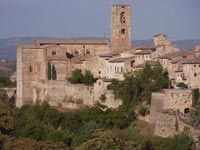 |
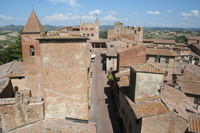 |
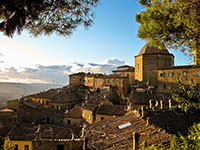 |
||
| Colle Cal dElsa | Certaldo | Volterra | ||


